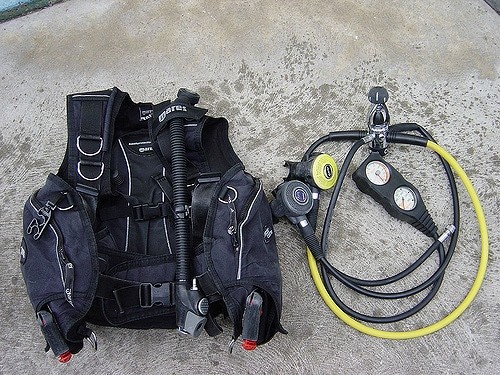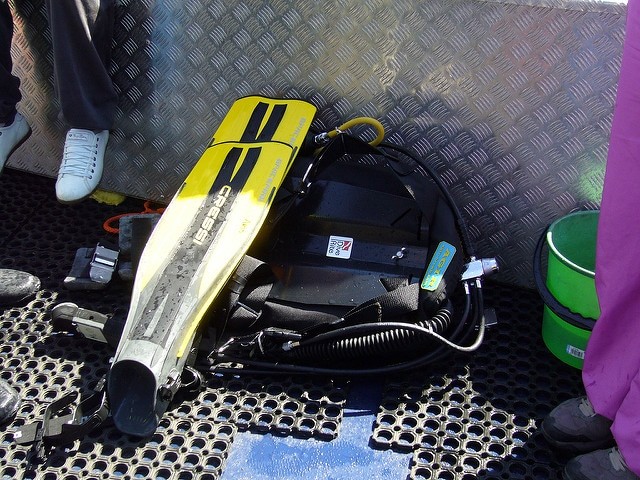It is getting to that time of the year when some divers will be calling it a season. Summer vacations are over and the “once a year” divers are starting to plan for next year. Divers that have local diving with changing water temperatures are either switching to dry suits or packing away their gear. For myself, I do not have a dry suit and no dive trips planned for the next 3 months, so it is Dive Kit Storage time for a while.
I wrote an article last year on the topic of cleaning your gear after a dive trip, you may want to review it. Many of the task you should do when you store your gear includes the task of cleaning your gear. Please refer back to the other article, I will try not to duplicate too much of that information.
Where to Store at Home
The garage may be perfect for your riding lawn mower, not so much for your scuba gear. Bats and trunks of old clothes can be found in the attic, your kit should not be. How about the basement then? Maybe not. To get the most out of your gear, you need to protect it from extremes in temperature and moisture. Some locations may also have a risk of chemical exposures, such as found in garages from automobile exhaust fumes. You need something that has environmental controls. Your kit has items which store best at different temperatures and humidity. A good compromise would be the air temperature maintained around 50-75°F/10-24°C and a relative humidity of around 50 to 55%. Lower relative humidity is better for the storage but may be difficult or expensive to maintain.
Your living space will likely meet the requirements of the climate needs perhaps with a little help from a dehumidifier. A non-living portion of a basement might be easily transformed into an acceptable storage area. Basements are naturally cool but seldom freezing if the living areas are heated. They may be damped, however, a simple dehumidifier may be all that is needed. All you need is a little space off the floor for to use as your dive kit storage area.
In an ideal situation, your kit would be spread out on a shelf, with the wetsuit hanging on a suitable hanger out of sunlight. However, if properly packed you could still use your dive bag.
Other Dive Kit Storage Options
Finding yourself without sufficient space within your home may require you to move off-site. Outside self-service storage facilities may be a potential storage space. However, you need to get one that meets the storage needs and that includes the climate-controlled requirements. While looking for a storage facility clarify any terms they may be used in the facility’s brochures and advertising. A temperature controlled facility may be different than a climate control facility. A temperature control facility normally just regulates the temperature. There is no control on the relative humidity, which is the amount of water in the air compared to how much water the air could hold at the current temperature. A high relative humidly would be uncomfortable for us but more importantly, create a foothold for mold to grow on our gear. A climate controlled facility will monitor and adjust both factors.

Regulators
The regulator is one of the more expensive items in your kit. It is also the item that is the most costly to maintain. Each manufacturer will have a “recommended” service interval. The thing is if you do not follow the “recommendation” you may find your warranty void. Frequently, when you take a reg in to be serviced, the dive shop may do an overhaul. This is where they tear the entire regulator down, clean everything, replaced worn parts, reassemble, make adjustments and a final inspection. It may be less expensive to just have them inspect and adjust as needed. Of course in order to do that you need to do your part first. That is the proper maintenance after each dive trip and before storing the gear. Proper maintenance of your gear may delay the need for an overhaul.
After you finish diving for the day, your regulator needs a good soaking. You want to make sure there is no build-up of salt nor sand. There are still some old times who will blow off the first stage dust cap with air from the dive tank. That is really not a good practice but does still happen. What you want to do is close the hole in the first stage with your thumb and then wipe down the dust cap and dry it off. When it is clean and dry, put it over the input in the first stage and tighten the yoke screw. Take a small sponge with warm soapy water and wipe down the mouthpiece. Use an antibacterial dish soap will help kill any germs. Rinse with clean water. If you have hose protectors, pull them away from the connectors and inspect for damage and corrosion. Out of sight out of mind is the problem here. Clean as necessary. It is then time to allow the regulator to soak in clean fresh water. Move the regulator around to help dislodge any sediments. Take a hose and run it into and around the mouthpiece and out the exhaust ports. However, do not push the purge valve. Doing so will allow water to enter the hose leading to the first stage which needs to remain dry.
When the soak is finished, allow it to air dry out of direct sunlight. While most people will hang a regulator on the first stage, many manufacturers disapprove of that method citing stress on the hoses caused by the second stage’s weight. Laying it out flat is the preferred method.
Before storing your regulator, wipe the threads of the yoke with a food grade silicone lubricant. Food grade silicon grease can also be used. Using either product, work the yoke to ensure that the threads are equally covered. Placing the regulator into a regulator bag where the hoses will not be kinked is best. Do not hang the regulators for storage, make sure they lay flat.
BCD and Wet Suits
Another big ticket item that you can extend the life of with proper care is the BCD. After each day of diving, you will want to clean your BCD. Start with a good soak in warm water. If you are soaking it with your wetsuit, it is okay to have wetsuit shampoo in the water or a mild soap like Woolite, however, do not use anything harsh or with cleaning agents. After 30 minutes or more, remove it from the water and check that there is no sand or dirt left on the BCD. Check the Velcro to make sure it is clean. Examine the seals looking for wear. Using the oral inflator, inflate the BCD to about half full. Carefully submerge the BCD in water. When fully submerged squeeze the BCD and look for air bubbles. If you see a small stream of bubbles you have a leak. Mark it so that you can later repair it. Next, take a hose and add water to the BCD by way of the oral inflator. Fill it at least ¼ full up to ½ full, add some air to the BCD and shake. Get the water sloshing around for a couple of minutes, drain and repeat. Use the different dump valves to drain. If you are going to store your gear, add some BCD conditioner in the last fill. Inflate the BCD until the overpressure valve releases and set it aside to dry. When the outside has dried, release any water that might have pooled within the BCD. Inflate and release the air. If you feel moisture in the air being exhausted, repeat the process. Store the BCD with some air in the bladders. This will help keep the material from coming into contact with another piece.
The wetsuit also needs a long rinse and it will help to have a wetsuit shampoo. This will help get any smells out of the suit. Dry it inside out. When fully dry, put some zipper wax on the zippers and hang up to store.
Mask And Fins
You will follow your basic cleaning instructions for these items as well. Pay close attention to the skirt of the mask and remove all sand and grit. Do not use anything on the mask but soap and water. Store your mask in the case that came with the mask and store it separate from other items.
Fins get a good soak and inspected for wear. If all is well, remove the straps and store flat. You might want to consider wiping them down with a silicone lubricant. However, make sure any lubricant stays away from silicon parts such as the mask’s skirt.

